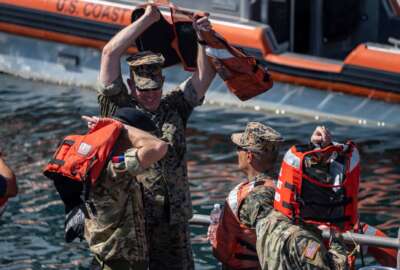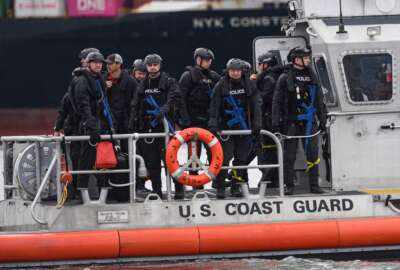The Coast Guard is one of the smallest military services — but it has a big mission. According to the Government Accountability Office, it is still struggling to meet that mission because of longstanding challenges in at least three major areas. To talk through where things stand and how the service can improve, Federal News Network’s Deputy Editor Jared Serbu spoke with Heather MacLeod, GAO’s Director for Homeland Security and Justice Issues on the Federal Drive with Tom Temin.
Jared Serbu Heather, thanks for doing this. And I know you recently testified about a few different aspects of the Coast Guard’s challenges, including the acquisition area, the workforce area and the technology area. Hoping we can hit briefly on all three, but let’s start with acquisition since that’s some of goes most recent reporting. I think the upshot of what you reported over the summer is that they’re going to face reduced operational capability, some I think more than 20 years after they started a huge project to recapitalize the Cutter fleet. Bring us up to speed on why they continue to be challenged in that in that acquisition project.
Heather MacLeod Yeah. So our most recent work looked at the new security cutters which are part of the law enforcement mission but support all the Coast Guard missions really. And we found, you know, delays and in the schedule and cost increases, pretty large delays and cost increases across the various assets. And you know what? This what really happens to the Coast Guard when this is going on is their existing fleet is aging. And so those are in need of greater maintenance. And some of them are being taken out of service. And so these delays really, you know, affect their ability to carry out the missions. And our reports in these areas had recommendations to the Coast Guard that they, you know, nailed down the plans ahead of the acquisition process and that they update their acquisition plans.
Jared Serbu And so it sounds like there’s kind of three things going on all at once. The new vessels are not coming online as quickly as they hoped that they would. They’re having to spend more money maintaining the legacy fleet. And to some extent, they can’t even do that anymore. So some of those cutters are going off line because they’re simply not able to be kept in the fleet. Is that about right?
Heather MacLeod Correct. Yeah. And it puts a lot of pressure on the Coast Guard and, you know, its workforce, which we which we commented on in this report about, you know, the Coast Guard is currently short its numbers. It hasn’t done the necessary workforce assessments that we’ve identified as part of their process to identify where their people should be. And so they’re really not helping themselves out here.
Jared Serbu Yeah. And as you point out in the testimony that the service itself has recently been talking about a workforce shortfall in the on the order of thousands of people, similar to the challenges I think the other military services are facing. But let’s talk about what you just said. They don’t really have a good grasp on what they need and where they need people in what missions, what do they need to be doing better to get a handle on that.
Heather MacLeod So the Coast Guard has a culture of making do in the area of workforce planning. You know, our recommendations really lie in pointing back to the Coast Guard in their own process on determining the workforce that they need. So they have this manpower requirements determinations, and that’s their official process. They’ve completed that process on 16% of the workforce the last time we checked in with them. And so by doing these determinations that are a part of their own process and they and they should be doing, we think they would have a better grasp on where they need their people. And this is especially important right now when the like you mentioned, they are facing a shortage.
Jared Serbu And one thing that’s always struck me as a little bit unusual about the Coast Guard is they tend to have a much lower portion of their total workforce in the civilian area. They seem to rely a lot more on military manpower for pretty much everything than the other military services do. I don’t know if that’s an issue GAO has looked at specifically, but I’m imagining those sort of workforce mix questions are the sort of things you would want to look at in a comprehensive workforce assessment.
Heather MacLeod Indeed, that’s certainly an issue. And we have looked at that in, you know, limited areas of the workforce. For example, in our work on the marine inspection workforce or the Coast Guard personnel that go out and inspect vessels. They’ve had a perennial shortage, you know, in this area, and they have employed civilians for this particular workforce. But again, that’s challenged. They’re having challenges even getting the civilian side, you know, due to the locations and some of the other workforce challenges.
Jared Serbu And let’s wrap up by talking about some of the technology challenges here. Every federal agency to some extent faces technology problems. We talk about that with GAO a lot. In what ways are the Coast Guard technology challenges unique?
Heather MacLeod So one of their key data systems, MISLE [Marine Information for Safety and Law Enforcement], for example, is well known to have challenges, even, you know, getting the most basic information out of it. One of the challenges that that it faces is the multi-mission nature of the Coast Guard. You know, they’re going out and they’re conducting various missions, come back and recording it in more in this data system that doesn’t allow for these multiple entries. And so it makes it hard to be able to really analyze what the Coast Guard is doing in an efficient way. In this report, we point out, and this is based on our prior work, that even running a simple data query that that you and I would think would be easy for them. How many migrant interdictions are they doing? Can take hours for them to compile this and some manual labor entailed in that. And that should be they should be able to just print that out in a more efficient manner. And so that data system in particular, which is one of its key data systems, is going to be replaced soon, but it has not been replaced yet. So they’re still using it and relying on it.
Jared Serbu Yeah. And as you point out, the challenges go beyond MISLE. There’s just underlying network infrastructure challenges, too, right?
Heather MacLeod Absolutely. Yep. Including cybersecurity as we’ve raised across the federal government.






